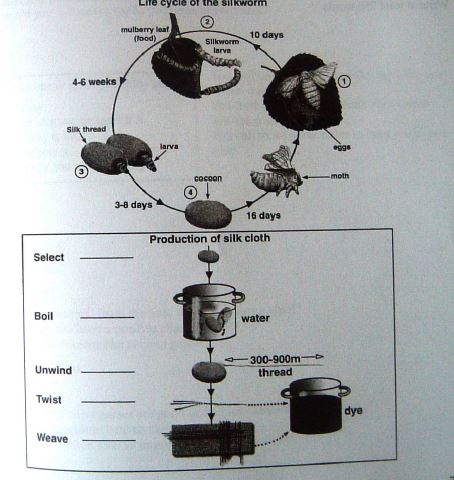The diagrams elow show the life cycle of silworm and the stages in the production of silk cloth. Summarise the information by selecting and reporting the main features and make comparisons where relevants.
Given are the diagrams explaining several changes of silkworm in its life cycle and how to produce silk cloth. Generally, there are four main stages of silkworm life cycle and five steps to create cloth made from silk.
In the term of silkworm life cycle, firstly, egg is hatched by moth. After 10 days, it develops to be larva form, consuming mulberry leaf as its daily food. Having silk thread, larva requires 4-6 weeks to approach this stage. In the last step, at 3-6 days later, larva transform to be cocoon then 16 days later it grows as a moth.
On the other hand, the initial step to produce silk cloth is by selecting and sorting the best quality of cocoons. Next, to make cocoons softy, these is boiled in the pan full of water. Thirdly, these cocoons are unwinded to collect 300-900 m thread, twisting it later. Finally, that product weave in flat wood. However, dying process is required in either twisting or weaving, aims to make silk cloth more attractive.
the diagram of silkworm
Given are the diagrams explaining several changes of silkworm in its life cycle and how to produce silk cloth. Generally, there are four main stages of silkworm life cycle and five steps to create cloth made from silk.
In the term of silkworm life cycle, firstly, egg is hatched by moth. After 10 days, it develops to be larva form, consuming mulberry leaf as its daily food. Having silk thread, larva requires 4-6 weeks to approach this stage. In the last step, at 3-6 days later, larva transform to be cocoon then 16 days later it grows as a moth.
On the other hand, the initial step to produce silk cloth is by selecting and sorting the best quality of cocoons. Next, to make cocoons softy, these is boiled in the pan full of water. Thirdly, these cocoons are unwinded to collect 300-900 m thread, twisting it later. Finally, that product weave in flat wood. However, dying process is required in either twisting or weaving, aims to make silk cloth more attractive.

6_diagram.JPG
